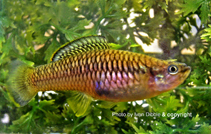| Family: |
Poeciliidae (Poeciliids), subfamily: Poeciliinae |
| Max. size: |
6 cm SL (male/unsexed) |
| Environment: |
pelagic; freshwater; pH range: 7 - 7.5; dH range: 5, non-migratory |
| Distribution: |
Central America: Río Térraba, Pacific drainage of Costa Rica to the Río Chiriquí, western Panama. |
| Diagnosis: |
Snout truncated. Anal fin much shorter than head length. Dorsal fin base very long. Vertical bars on body more conspicuous in adults, reduced to very short bars on the midline. Some populations have a dark band along the body, may be absent or diffuse on fish of other regions. Caudal fin bluish white on the margin, the proximal half is colorless and the intermediate area is darkened, especially in males. Distal half of dorsal fin yellow or orange; edge of first rays of anal fin orange or red, the black blotch sometimes absent. Bluish green highlights on iris, cheek and scales above pectoral fin (Ref.36880). |
| Biology: |
Inhabits stagnant waters or currents of all velocities between 40-1250 m of elevation; mainly in waters of moderate flow in brooks and creeks at temperatures of 20-23°C. Feeds on terrestrial insects (Ref. 36880). |
| IUCN Red List Status: |
Near Threatened (NT); Date assessed: 17 September 2019 (B1ab(iii)) Ref. (130435)
|
| Threat to humans: |
harmless |
Source and more info: www.fishbase.org. For personal, classroom, and other internal use only. Not for publication.

